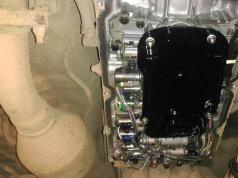Currently, there is an acute shortage of technical specialists in Russia and abroad. In connection with the constant modernization of production, new, modern equipment and automated lines are being installed instead of outdated ones. There is a need for specialists who can carry out the installation, commissioning and testing of this equipment, and its further operation.
Due to the unique advantages of hydraulic machines, hydraulic drives and hydropneumatic automation, now it is difficult to name the field of technology, wherever a hydraulic drive is used. All modern production is automated due to electrohydraulic and pneumatic drives. These types of drives are used in the automotive industry, mechanical engineering, light industry, the food industry, all types of transport, medicine, the military industry, and the energy industry. All this makes the specialty " Technical operation hydraulic machines, hydraulic drives and hydropneumatic automation ”is promising, and its graduates are in wide demand both now and in the future.
Upon graduation, the graduate will be able to perform work related to the installation, adjustment, maintenance and repair of hydro-automatic machines, hydraulic drives products, hydraulic and pneumatic equipment, installation and commissioning of hydraulic systems of hydraulic equipment products, with technical diagnostics hydraulic systems, laboratory control of the quality of fluids of hydraulic systems, with testing and determination of the operability of repaired hydraulic machines. In theoretical studies, multimedia training systems are used: "Specialist in hydraulic equipment converter ". The main task of the simulators is the development of practical skills with simultaneous theoretical training. Practical skills are practiced in the educational and laboratory complex" Industrial controllers, pneumatic-hydraulic automation ", aimed at developing skills in the installation and commissioning of hydraulic systems and maintenance hydroaccumulators, hydraulic lines, seals, instrumentation, practice of assembly skills, testing and commissioning schematic diagrams typical hydraulic drives, determination of the performance of units and hydraulic drive assemblies. Employment is possible at the metallurgical enterprises of OJSC "MMK" to work with hydraulic machines, hydraulic drives, hydropneumatic automation in workshops.
Specialty code: 15.02.03
| Specialty information | |
|---|---|
| Basic education | Basic general (9 grades) |
| Form of study | Full-time |
| Language of instruction | Russian |
| Qualification | Technician |
| Training period | 3 years 10 months |
| The level of education | Basic training |
The profession of workers in the framework of the main educational program.
students gaining general and special knowledge and skills in the field of operation of hydraulic drive systems and hydroautomatics (GP and GPU).
MEANS OF MAKING THE COURSE
- Educational-methodical literature, handouts.
- Complex experimental stands of hydraulic drive and hydroautomatics.
- Split models of hydraulic devices.
- FluidSIM-H (FESTO) program.
- A set of presentations and videos "Elements of hydraulic drive systems".
- A set of application models for the elements of hydropneumatic drive systems and hydropneumoautomatics.
APPROVAL FORM
- credit, performance by the student of practical work provided for by the curriculum.
EVALUATION MATERIALS
- Provided to listeners individually, upon completion of the program, in the form of a writing test and a number of practical tasks, according to the content of the course of study.
Basic concepts of hydraulics.
- The subject of hydraulics and its application in hydropneumatic systems.
- Working fluids of hydraulic drive systems and their properties.
- Basic concepts of hydrostatics. Pressure force, pressure and its properties.
- Hydraulics of pipelines.
- Flow rates and rates of fluid flows, heads, head losses. Modes of movement, Reynolds number.
- Calculation of hydraulic losses: along the length of the pipeline, in local hydraulic resistances.
- Liquid characteristics. Functions of hydraulic fluids.
- Water hammer in pipelines. Cavitation: causes of occurrence, impact on wear of OGP materials.
VOLUME HYDRAULIC MACHINES
- General properties of volumetric hydraulic machines. Definitions, basic parameters. Classification.
- OGP pumps and hydraulic motors. Operating parameters of volumetric hydraulic machines.
Hydraulic drive and automation equipment
- Governance structure and regulation of UCP. Distribution and guiding equipment of the UGP.
- Pressure valves, pressure and pressure reducing valves.
- Chokes, flow controllers.
- Check valves, hydraulic locks, seat valves.
- Flow dividers.
- Hydraulic tanks and hydraulic lines. Hydraulic accumulators, pumping stations.
- Management of the working cycles of the UGP. Methods and schemes for controlling hydraulic drives. Speed and effort control executive mechanisms Displacement and pressure control.
- Types of work cycles and typical schemes for their implementation.
- Calculation of pressure in a liquid at rest and pressure forces on solid surfaces. Conversion of pressures and efforts.
- Calculation of energy losses in the pipeline when the temperature of the working fluid changes.
- Calculation of energy losses in the pipeline when changing the flow rate of the working fluid.
- Calculation of the speeds and forces of the forward and reverse stroke of the hydraulic cylinder rod.
- Diagrams of the functioning of hydraulic systems.
- Learning the FluidSIM-H program
- Practical work "Console - rotary stand".
- Practical work "Scoop filling device".
- Practical work "Pipe cutting machine".
- Practical work "Drilling machine".
- Practical work "Milling machine".
Laboratory workshop
- Reading the characteristics of the unregulated pump.
- Characterization of direct and indirect pressure valves.
- Reading the characteristics of a three-way pressure reducing valve.
- Withdrawal consumption characteristics adjustable throttle.
- Reading the characteristics of a two-way flow regulator.
- Experimental study of the operation of a hydraulic drive with a one-way hydraulic lock.
- Experimental study of the operation of a hydraulic drive with a pneumatic hydraulic accumulator.
- Experimental study of the operation of a hydraulic drive with a throttle flow divider.
- Study of the tightness of hydraulic devices.
Course feedback
Many thanks for the work done on training, for the excellent and understandable presentation of the material, for the attentiveness to the students. I liked the course very much - it was interesting and informative. A good educational base, information is available and useful, the quality of teaching is at a high level, practical exercises provide the most necessary skills. A pleasant impression was left not only from the staff of the institute, but also from the learning process. I wish you further development, an increase in the number of courses, success and prosperity of the UDPO "MITI".
N.V. NevolinDeputy Chief Mechanic of OJSC "Tyazhmash", Syzran
Details Views: 22565Most people are familiar with the words "hydraulics", "hydraulic machines", "hydraulic drives". However, only specialists represent the vast world of technology, science and technology, which is hidden behind them. What will school graduates answer if asked to explain these words? Probably, someone will say that it is somehow connected with the water supply system, another - that this is about all sorts of devices where there is oil under pressure and there is certainly an oil puddle around, and the third - that these are solid formulas and drawings. Who will you actually become after graduating from our department, where will you be able to work and what kind of work can it be?
The range of tasks that you can solve is extremely wide. Hydraulic machines and devices, various hydraulic and pneumatic systems are used literally everywhere. These are water supply and sewerage, oil production and transportation, construction of buildings, bridges, tunnels and other structures, road construction equipment, machine tools, presses and other technological equipment, cars, airplanes, missiles, ships, robots, military and other special equipment. Everywhere there is an interesting and well-paid job for a hydraulic engineer.
Hydraulics is an extremely knowledge-intensive field of technology. Various pumps, hydraulic motors, other hydraulic machines and devices cannot be created without knowledge of the mechanics of fluid and gas - one of the most complex scientific disciplines. When creating hydraulic drives and devices, hydroautomatics use the theory automatic control, which in the middle of the twentieth century made a real revolution in technology. Most modern hydraulic devices and systems include electronic systems control and management, built on the basis of various controllers, functioning algorithms, and often programs, for which hydraulic engineers also create. Well, modern engineers conduct the design and research of all these machines, devices and systems on computers using a variety of design automation and scientific research packages.
As the name of the specialty (profile) suggests, our students study hydraulic machines, hydraulic drives, as well as hydraulic and pneumatic devices. Hydraulic machines convert mechanical energy into fluid flow energy (pumps), or vice versa (hydraulic motors). There are a huge number of types of hydraulic machines, and they are used wherever fluids are used. Hydraulic drives are designed to drive various mechanisms of a wide variety of machines using the energy of a fluid flow. Due to the complex of unique properties, hydraulic drives are also widely used. Means of hydro- and pneumatic automatics make it possible to create control systems for machines and drives, sometimes without the use of electricity at all, which in some cases makes them simply irreplaceable. In their senior years, our students have the opportunity to specialize in one of these sections and study it in more depth.
Vane pumps are the most common type of hydraulic machine. Their main purpose is to transport various liquids, and the scale can be very different - from working in oil trunk pipelines stretching for thousands of kilometers to pumping liquid (for example, lubricant) within one unit of a machine.

Another wide famous species hydraulic machines are hydraulic turbines. They convert the energy of a fluid flow (for example, a river) into mechanical energy, which can be transmitted from the turbine shaft to other machines, such as electric generators. Sometimes vane pumps and turbines are combined in one unit. For example, turbopump units (albeit with gas turbines) are used to supply fuel to rocket engines. Fluid couplings provide a "soft" connection of the shafts of high-powered machines, and torque converters allow cars with automatic transmissions to start smoothly and shift gears without jerking while driving.

Another type of hydraulic machines is volumetric hydraulic machines. They are usually used as energy converters in hydraulic drives and hydraulic transmissions. It can be both pumps and hydraulic motors. Positive displacement pumps are capable of delivering very high pressures. For example, in the hydraulic systems of road construction machines, a fluid is used under a pressure of 350 atmospheres, and sometimes even more. In construction and rescue equipment, the fluid pressure reaches 800 atmospheres. There are positive displacement pumps capable of creating water pressure up to 10,000 atmospheres. The water jet formed under this pressure cuts even hard metals. Volumetric hydraulic machines are also widely used in aircraft and rockets, on ships and underwater vehicles, in powerful robots, machine tools and hydraulic presses.

Hydraulic drives are used to set in motion with the energy of a fluid flow various cars and mechanisms. For example, with their help, excavators dig the ground and move from place to place. Hydraulic actuators work in brakes, steering and automatic boxes car gears. With their help, rudders, ailerons, aircraft wing mechanization elements are set in motion, and the landing gear is released and retracted. Hydraulic drives are part of missile, cannon and tank control systems. They are also used on powerful manipulators. In mines, hydraulic drives are installed on powered supports. They are widely used on cranes and other road construction equipment. Hydraulic drives have a unique set of qualities that make them very common, and sometimes indispensable: high power density, excellent speed, ability to work in a wide range of external temperatures, mechanical strength, compactness, resistance to aggressive environments, vibrations, shocks ... The list goes on.

Hydraulics are indispensable wherever a lot of effort is required. In industry, these are various hydraulic presses, devices for clamping workpieces. In construction, these are powerful jacks with which you can lift entire bridges and even move them assembled from one side of the river to another.

In construction, hydraulic technology is also used for other purposes. With the help of pumps, water is supplied for various technological purposes. Hydraulically driven concrete pumps pump liquid concrete from mixers into the formwork when erecting monolithic reinforced concrete structures. Special cement slurries are pumped (injected) into long channels for reinforcing steel ropes, which run along the entire length of the spans of bridges and overpasses made of reinforced concrete.

Hydraulic drives can be very accurate. Often on large machines, they are used to move workpieces and tools during machining. They are also installed on heavy-duty robots.

Pumps, hydraulic drives and various hydraulic equipment are widely used in aviation. Vane pumps transfer fuel from tanks to engines. The engines are equipped with regulator pumps that supply fuel under high pressure to the combustion chambers of jet engines. They also perform engine control functions. Variable speed pumps driven by engine turbine shafts supply working fluid under pressure of hundreds of atmospheres, many actuators that set in motion almost everything that moves in the plane: elevators and rudders, ailerons, flaps, slats, spoilers, servos that provide control of the aircraft from the autopilot. The landing gear of the aircraft is also retracted and released hydraulically. If the aircraft has a working hydraulic system, then it can be piloted and land even if there is no power supply on board.

Another area where hydraulic engineering is irreplaceable is hydraulic power tools. With the help of hydraulic tools, you can easily bend thick steel pipes, cut fittings, tighten huge nuts, for which a person would not be able to lift wrenches at all. Due to their low weight, dimensions, and the ability to develop enormous efforts, hydraulic tools have proven to be indispensable in various emergency recovery and rescue operations. With hydraulic shears, the body can be quickly cut wrecked car and rescue the person trapped in it. Hydraulic cutters and nippers allow you to remove debris from reinforced concrete structures after earthquakes and explosions. These tools are powered by lightweight mobile pumping stations.

Hydraulic systems, including hydraulic machines, hydraulic drives, various hydraulic equipment are used very widely in various industries. Our students easily find work in their specialty already in their senior years. Graduates work in industrial enterprises, in research institutes and design bureaus of various profiles, in construction organizations, in enterprises related to the production and transportation of oil and gas. Work for hydraulic engineers is also found in trade organizations. Many foreign manufacturers of pumps and other hydraulic equipment are promoting their products in our market. They need sales consultants, engineers for warranty and post-warranty maintenance of equipment, as well as designers who are able to design unique hydraulic systems at the request of the customer from the company's components. Some foreign firms organize their own training centers, which also attract our graduates.
Since 2011 MSTU im. N.E. Bauman goes to a multi-level education system. Our department begins training bachelors and masters in the field of "Hydromachines, hydraulic drives and hydropneumatic automation" in the framework of the direction "Power engineering". Educational plans are designed in such a way that our bachelors receive a full-fledged engineering education. Most of the students will be able to continue their studies in the master's degree. The most talented students after graduating from the magistracy have the opportunity to enter graduate school and conduct their own scientific work.







